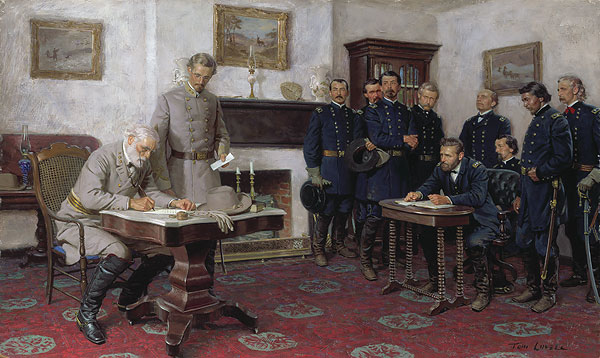| March 25 |
Battle of
Fort Stedman:
Lee throws a large portion of his army, under
the immediate command of Lt. Gen. John Gordon, against the Federal
lines east of Petersburg. The objective is Fort Stedman, and
the idea
is to force Grant to perhaps contract his lines some, which would make
it easier for Lee to escape westwards. The effort is a
failure,
costing the Confederates perhaps as many as 4,000 men (against Union
losses of about 1,000), which they could
ill afford to lose. That evening, Federal forces advance and
seize the
Confederate advance pickett lines along much of the Petersburg lines,
resulting in a series of sharp fights that cost about 1,200 Federals
and 1,600 Confederates. |
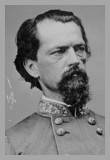 |
| Lt.
Gen. John B. Gordon |
|
| March 26 |
In the wake of the disaster at Fort Stedman, Lee writes to President Davis:
HDQRS
CS Armies
26th March 1865
His Excy Jefferson Davis
President C States
Richmond,
Mr President,
My
dispatch of yesterday to the Secretary of War will have informed you of
the attack made upon a portion of the enemy’s lines around Petersburg,
and the result which attended it. I have been unwilling to hazard any
portion of the troops in an assault upon fortified positions,
preferring to reserve their strength for the struggle which must soon
commence, but I was induced to assume the offensive from the belief
that the point assailed could be carried without much loss, and the
hope that by the seizure of the redoubts in the rear of the enemy’s
main line, I could sweep along his entrenchments to the south, so that
if I could not cause their abandonment, Genl Grant would at least be
obliged so to curtail his lines, that upon the approach of Gen Sherman,
I might be able to hold our position with a portion of the troops, and with a select body
unite with Gen Johnston and give him battle. If successful, I would
then be able to return to my position, and if unsuccessful I should be
in no worse condition, as I should be compelled to withdraw from James
River if I quietly awaited his approach. But although the assault upon
the fortified works at Hair’s Hill was bravely accomplished, the
redoubts commanding the line of entrenchments were found enclosed and
strongly manned, so that an attempt to carry them must have been
attended with great hazard, and even if accomplished, would have caused
a great sacrifice of life in the presence of the large reserves which
the enemy was hurrying into position I therefore determined to withdraw
the troops, and it was in retiring that they suffered the greatest loss
the extent of which has not yet been reported. I fear now it will be
impossible to prevent a junction between Grant and Sherman, nor do I
deem it prudent that this army should maintain its position until the
latter shall approach too near. Gen. Johnston reports that the returns
of his force of the 24th inst; gave his effective infantry thirteen
thousand five hundred. He must therefore have lost, after
his concentration at Smithfield about eight thousand men. This could
hardly have resulted from the casualties of battle, and I fear must be
the effect of desertion. Should this prove to be the case, I can not
reasonably expect him to bring across the Roanoke more than ten
thousand infantry, a force that would add so little strength to this
army as not to make it more than a match for Sherman, with whom to risk
a battle in the presence of Grant’s army, would hardly seem
justifiable. Gen Johnston estimates Gen Sherman’s army, since its union
with Schofield and the troops that were previously in N Carolina, at
sixty thousand. I have no correct data upon which to form an estimate
of the strength of Gen Grant’s army. Taking their own account, it would
exceed a hundred thousand, and I fear it is not under eighty thousand.
Their two armies united would therefore exceed ours by nearly a hundred
thousand. If Gen Grant wishes to unite Sherman with him without a
battle, the latter after crossing the Roanoke has only to take an
easterly direction towards Sussex, while the former moving two days
march towards Weldon, provided I moved out to intercept Sherman, would
render it impossible for me to strike him without fighting both armies.
I have
thought it proper to make the above statement to your Excellency of the
condition of affairs, knowing that you will do whatever may be in your
power to give relief.
I am with great respect
Your obt servt
R E Lee
Genl
|
|
| March 26 | Orders
are issued for the Army of the Potomac to move out to the left at 3:00
a.m. on the 29th. Maj. Gen. E.O.C. Ord, commanding the Army of
the James, is ordered to take three divisions to replace Second Corps
in the lines southwest of Petersburg. Sheridan's cavalry command
is ordered (on March 28) to move out for Dinwiddie Court House at 5:00
a.m. on the 29th. | |
| March
29 |
Maj.
Gen. Gouvernor Warren's Fifth Corps, moving northward along the
Quaker Road southwest of Petersburg, encounters Confederates under
Bushrod Johnson at the Lewis
Farm.
A sharp fight results, with Chamberlain's brigade leading the
attack,
and the day ends with Fifth Corps across the vital Boydton Plank Road
and within striking distance of the White Oak Road, the main east-west
avenue in the area. Second Corps, under Humphreys, kept pace
on
Warren's
right and remained connected to Ord's troops. Sheridan's
cavalry reaches the vicinity of Dinwiddie Court House. |
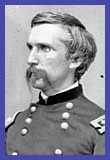 |
| Brig.
Gen. Joshua L. Chamberlain |
|
| March 30 |
Heavy rain brings
almost all operations to a stop. Sheridan advances to the
vicinity of Five Forks. Pickett's infantry arrives in the
vicinity of Five Forks, along with the cavalry divisions under Fitz Lee
and W.H.F. Lee. |
|
| March 31 |
The Battles of Dinwiddie
Court House and White
Oak Road:
At about 11:00 a.m. Pickett attacks Sheridan's advanced divisions
in front of
Five Forks and, on the left, along a swampy stream known as
"Chamberlain's Bed." The attacks are successful and Sheridan is
forced back to a position in front of Dinwiddie Court House at dark.
(In fact, one of Pickett's subordinates thinks he should have
continued the fight after nightfall.)
Meanwhile, Warren had reported that morning that he could get
possession of
the White Oak Road, but his advance is so clumsy that a counterattack
by four Confederate brigades (one of which did not really participate)
is able to rout two Fifth Corps divisions. A Federal
counterattack by the remaining Fifth Corps division, supported by a
division under Nelson Miles of Second Corps, is able to recover the
situation and the fighting ends with part of Fifth Corps across White
Oak Road. Pickett is now cut off from the rest of Lee's army. |
|
| April
1 |
The
Battle of Five Forks:
After a night of confusing and contradictory orders and
counter-orders, Warren finally gets to near Dinwiddie Court House at
around 8:00 a.m. At about 4:00 p.m., Warren leads Fifth Corps
against the right flank
of
Pickett's line covering Five Forks. The attack is initially
mis-placed, but the Federal force is too strong and the Confederates
are badly beaten, with 4,500 prisoners taken. Lee's right flank
is
irrevocably turned, but Warren is relieved of his command at the end of
the battle, an action that is controversial to this day. |
 |
| Maj. General G. K. Warren |
|
| April 2 |
Breakthrough
at Petersburg: At
4:30 a.m., elements of Ninth Corps assault the Confederate lines near
Fort Mahone. Although initially successful, the attack bogs down
and eventually stalls. At 4:40 a.m., Sixth Corps (under
Wright)
attacks in force along the Boydton Plank Road line and shatters the Confederate defenses.
A
pair of stragglers from this attack shoot and kill Confederate Gen.
A.P. Hill.
Humphreys (Second Corps) attacks near Hatcher's Run and also
breaks through. Troops from the Army of the James take Fort
Gregg, but not in time to prevent Lee from holding Petersburg for the
night. Lee evacuates during the night. |
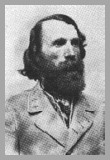 |
| Lt.
Gen. A. P. Hill |
|
| April 3 |
The fall of
Richmond and Petersburg: The results of the fighting on April 2nd meant
the Confederates would have to evacuate Richmond and Petersburg.
Warehouses were ordered burned in Richmond, which started a
conflagration that destroyed much of the downtown area. The army would
head for Amelia Courthouse, about 40 miles away on the Richmond and
Danville RR; the government would head for Danville, Virginia, near the
North Carolina border. Trainloads of provisions were ordered to meet Lee's men at Amelia.
On the Federal side, both cities were occupied in the
early morning.
Credit for the first troops in to Petersburg usually goes to a pair of
Michigan regiments from Ninth Corps, which set United States flags up
on a couple of public buildings. A Massachusetts cavalry regiment was
the first to enter Richmond. Fittingly, some of the first troops into
the Confederate capital were USCT regiments. Lincoln entered Petersburg
and met with Grant at the Wallace House in mid-morning. An
account of raising the first United States flag in Richmond can be
found here.
The only fighting of note was between Confederate
forces and Union cavalry at Namozine Church, west of Petersburg, as
Sheridan was continuing his pursuit of the remnants of the force he had
fought at Five Forks. Confederate General Rufus Barringer of North
Carolina was captured in this fight.
|
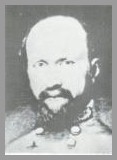 |
| Brig.
Gen. Rufus Barringer |
|
| April 4 |
Lee
begins to concentrate at Amelia. Longstreet's First Corps arrives
in the morning, Third Corps throughout the afternoon. But the
trainloads of rations are not there, so the army is forced to forage
through the immediate countryside, to little effect.
Meanwhile,
the Federal pursuit begins. Crook's Federal cavalry division
arrives
along the Richmond and Danville RR in the morning, followed shortly
thereafter by more cavalry and the infantry of Fifth Corps.
Second Corps and Sixth Corps get as far as Deep Creek, a short
distance east of Jetersville. Sheridan's
remaining cavalry and Fifth Corps begin to arrive at Jetersville at
about 5 p.m. General Ord, with three divisions from the Army of
the James, along with Ninth Corps, would move along the Southside RR
towards Burkeville Junction. Meade was with Second and Sixth
Corps; Grant, traveling with Ord's column, reached Wilson's Station on
the Southside RR, from which he telegraphed Secretary of War Stanton
with a progress report. |
|
| April 5 |
Confederate formations continue to arrive
at Amelia Court House. Lee
considers attacking the Federal force at Jetersville (still consisting
of only Fifth Corps and the cavalry) in order to push it out of the
way, but is
concerned about more Federal infantry arriving on his left
flank. Second and Sixth Corps arrive in the afternoon; part
of Ord's column begins to arrive at Burkeville during the night.
Sheridan
thinks that the Confederates are trapped, but fears that they may get
away if Meade is left to manage things, so he sends a courier to find
Grant, who is with Ord's column at Nottoway Court House. Grant
decides to make the 14 mile ride to Jetersville at night, accompanied
by four staff officers and fourteen cavalry as escort. They reach
Federal lines at about 10:00 p.m. |
|
| April 6 |
As
Federal troops advance to attack the Confederate position near Amelia
Court House, Lee has already begun a night march, first to the north
and then west, towards Farmville, where provisions are ordered to meet
the Confederates. Meade and Grant pursue Lee directly, with
Second and Sixth Corps. Sheridan, with the cavalry, takes a
parallel route south of Lee. Skirmishing occurs throughout
the
day, with Federal cavalry dashing up side roads to attack the
Confederate column, hit-and-run style. The Confederate column
is
badly strung out; Lee is riding with the lead elements, and a
lengthy wagon train divides Gordon's Second Corps, the rear-guard, from
the rest of the army. At Sayler's Creek, disaster strikes the
Confederates as three separate small engagements result in the loss of
some 7,700 men from Lee's army, including numerous general officers
captured,
among them Maj. Gen. Joseph Kershaw, Lt. Gen. R.S. Ewell, and Lee's oldest son, Custis. At the end of the day,
Lee's
force is near Rice's Station on the Southside RR, while the Federals go
into camp about two miles beyond the battlefield.
A Federal attempt to destroy the strategic High Bridge near Farmville
failed, resulting in the capture of some 400 men. |
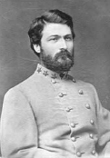 |
| Maj.
Gen. G.W.C. Lee |
|
| April 7 |
Lee's
army begins another night march, this time for Farmville where
provisions are supposed to be found. Mahone's Division, with
the
remnants of the commands that fought at Sayler's Creek, is
directed to march to High Bridge, cross over it, and the destroy both
it and the smaller bridge for wagon traffic. Longstreet is
directed to take the rest of the army to Farmville, where rations are
supposed to be waiting for the army. Lee is able to briefly
meet
with Confederate Secretary of War Breckinridge, but the approch of
Federal cavalry upset the plans to distribute the rations.
Lee
orders the trains run westward where they might be met the next day,
and orders his army across to the north side of the Appomattox River,
burning the bridges behind them.
One of Lee's most perceptive
officers, the artillerist Col. Edward Porter Alexander, thought this
was a fatal mistake. The army was now caught in a sort of
peninsula formed by several deep watercourses, and the only way out was
via Appomattox---and the distance from Farmville to Appomattox along
the south side of the river was shorter than along the north side.
"Well, there is time enough to think about that," was Lee's only
response
Gen.
Meade sends Second Corps after Mahone at about 5:30 a.m.; they
reach High Bridge too late to save several of the westernmost spans,
but the parallel wagon bridge is saved by the 19th Maine and so the
Federals are able to cross the river. Meade has been ill for
much
of the pursuit---yesterday he rode a horse, but the effort caused him
to relapse so he now is riding in an ambulance and is not happy about
it. Humphreys is across the river by about 9:30, and at about
1:00 p.m. he comes upon the Confederates entrenched in a defensive line
near Cumberland Church. An attack is launched at about 3:00
p.m.
and the fighting continues until about 6:30, with the Confederates
holding their line.
The rest of the Federal force---the
cavalry, Fifth Corps, Sixth Corps, and Ord's Army of the James
column---would make for Farmville.
Grant
arrived in Farmville sometime in the afternoon and took up residence in
the Randolph House Hotel, where he issued the orders for the next day.
Sixth Corps should cross to the north side of the river and
join
Second Corps in directly pursuing Lee. Fifth Corps and Ord's
column (Ninth Corps had been left at Nottoway Court House) would make a forced march along the south side of the river in
an effort to get ahead of Lee. Sheridan with the cavalry was
already dashing ahead along the south side of the river. Then
Grant wrote a letter to General Lee, to be dispatched by an orderly
under flag-of-truce:
APRIL
7,
1865.
General
R. E. LEE:
GENERAL:
The result
of the last week must convince you of the hopelessness of further
resistance on the part of the Army of Northern Virginia in this
struggle. I feel that it is so, and regard it as my duty to shift
from myself the responsibility of any further effusion of blood by
asking of you the surrender of that portion of the C. S. army known
as the Army of Northern Virginia.
U.S.
GRANT,
Lieutenant-General
Lee
received the letter at about 9:30 in the evening. "Not yet,"
was
the advice given by Lee's most senior subordinate, Lt. Gen. James
Longstreet. A letter to that effect was sent back to
Farmville,
arriving at Grant's room after midnight.
|
 |
| Col.
E.P. Alexander |
 |
| Lt.
Gen. James Longstreet |
|
| April 8 |
Grant
began the day by responding to Lee's note of the previous evening, then
crossed the river to continue the pursuit with Meade. Second
and
Sixth Corps continued to press the Confederates, but were unable to
force them to halt. The generals stopped for the night at a
house
with a piano, which was most unfortunate, as a gaggle of staff officers
began pounding on the keyboard, oblivious
to the fact that Grant was totally tone-deaf and hated
all music ("I only know two songs," he wrote in his Memoirs,
"One is Yankee Doodle, and the other one isn't."), and in addition was
suffering from a migraine. His headache did not improve when
another letter from Lee arrived, offering only to meet to discuss "the
restoration of peace...," a turn of phrase that sent Grant's adjutant,
the tempermental Brig. Gen. John Rawlins, into a minor tirade.
A
second note came from Sheridan, and it contained much better news.
The hard-driving Irishman had reached Appomattox Station,
where
his troopers captured a lot of artillery and four trains full of
rations for Lee's men. The Yankee cavalry were in front of
Lee,
and if Fifth Corps and Ord could make a hard night's march to bolster
the line, Lee was trapped. |
|
| April 9 |
Since
the debacle at Sayler's Creek, the Army of Northern Virginia has been
moving with Gordon's troops in the lead, and Longstreet and Mahone
acting as the rearguard. Thus it falls to Gordon to lead the
final attack in the history of the Army of Northern Virginia.
At
5:00 a.m. he leads a desperate and forlorn attempt to break through to the
west, by attacking the (slightly entrenched) Federal cavalry blocking
the Lynchburg Road.
Initially successful, the effort fails when Federal infantry
from
Fifth Corps and the Army of the James appear on his left flank and
across his front. Meanwhile, Meade with Second and Sixth
Corps is
pressing Lee's rear, only a few miles away. With escape
impossible,
Lee says, "Then there is nothing left me to do but to go and see
General Grant, and I would rather die
a thousand deaths." White flags begin to appear along
Gordon's
lines. At about 3:45 p.m., Lee surrenders the Army of
Northern
Virginia
to Grant in the parlor of the McLean house. |
|








